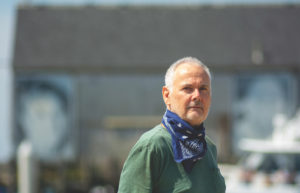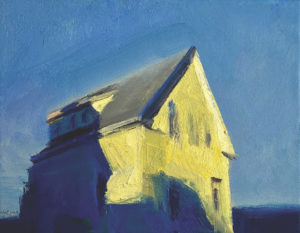
The painter Chet Jones normally doesn’t talk to journalists about his art. “I’m very unpromoting,” he says. “I know that’s a sacrilege to say, because so much art is built around publicity and marketing. In my view, the soul of art is introspective, and that is antithesis to our media culture. We live in a sound-bite culture, and I think art deserves more.”
The Provincetown painter, who is having a show of new work at William Scott Gallery that opens Friday, views life in an almost Zen-like manner that carries over into his paintings. Listening to Jones is like being immersed in the transcendental poetry of Walt Whitman and William Blake, or the Point Lobos landscapes of Edward Weston.
“I don’t want to think in terms of careers,” Jones says. “I want to think in terms of questions, like: What’s happening now? What’s in front of me? Where am I? What is this like? What is this moment? What am I looking at?”

With his art, Jones challenges us to stand at the edge of the land and experience the ocean, to watch sunlight rake across a landscape and understand what you’re really seeing.
“We often see things in terms of clichés, and we have to get through the mental noise and be with the experience, in its presence,” Jones says. “My goal is to respond to the moment and see what happens.”
Jones perceives a transformation happening around him. “Right now, the world is based on division and greed and profit-making,” he says. “There is a movement appreciating the Earth and the ecosystems that support and nurture us.”
Just as socioeconomic forces shift, so does painting. Over the course of 10 years or so, Jones’s work has evolved from head-on views of houses and outbuildings shown in relatively flat planes of color, to canvases of fierce, searing, violent color, in which the light illuminates like a sudden blast from a nuclear explosion. Perspective has shifted. We look from below, obliquely, on edge with two-point perspective. With such purely descriptive titles as Yellow House in the Afternoon, Truro Barn, and Dune by a Highway, Jones seems to be teasing or testing us to “get through the mental noise” — to get past our preconceptions.
“I’m looking for the unseen,” Jones says. “The light transforms everything in a landscape, and I work starting with the light and shadow. It’s a very mystical, meditative light. I’m trying to express the ephemeral. It’s a lofty goal, to see the deepness of things.”
Jones was born in 1957 and raised in Sharon. He says he didn’t know it at the time, but he benefited from being surrounded by people for whom it was important to have goals and purpose. “Because of that culture, you really had to work,” he said. “I think I got a lot of that through osmosis.”
As a youngster, Jones took advantage of Boston museums and culture that were only a train ride away. In grade school, he sold newspapers to pay for art classes. “I knew I was passionate about art — I just didn’t know how to make a career out of it,” he said. “There is no path to it. You have to figure it out on your own.”

He enrolled at Boston College, dropping out for a year for what he realizes, in retrospect, was a time to figure out how was he going to make it as an artist. “I attended what was then SMU/Dartmouth for its art program. I didn’t like it there, and decided to go back to BC, but this time with plans to stay in liberal arts and major in studio art,” he says.
In his early 30s, he was working as a freelance desktop publisher for a magazine on the Cape when he became aware of the Provincetown arts community. “I thought, why didn’t I think of this before?” he said. “I went up to P’town and decided this is it.”
Little by little, people began to respond to Jones’s work. “I was nurtured by the galleries and bonded very quickly to the whole scene,” he says. He continued working in his studio in Sharon, a converted barn that his father let him have for free, but he began taking longer and longer forays to Provincetown, finally taking advantage of cheap rents to stay a winter. Eventually, the day came when he made the move.

“I’m so lucky to be here,” he says. “If I arrived now, I don’t think I could have done the same thing. It’s transformed so much in 25 years. I walked in at the end of the bohemian period. You could still find inexpensive winter rentals. But it became a mecca for investors, and there was a great exodus. All the artists and writers I hung out with have gone. It’s shocking. I mourn the loss of that, and I don’t think it’s coming back.”
A Jones for Color
The event: An exhibit of new work by Chet Jones, showing alongside work by Paul Wirhun
The time: Friday, Aug. 21, through Sept. 2
The place: William Scott Gallery, 439 Commercial St., Provincetown
The cost: Free



